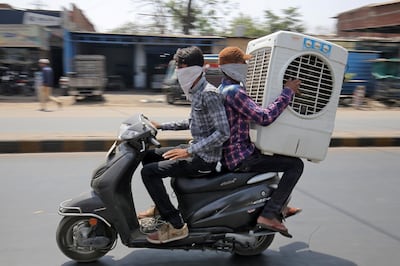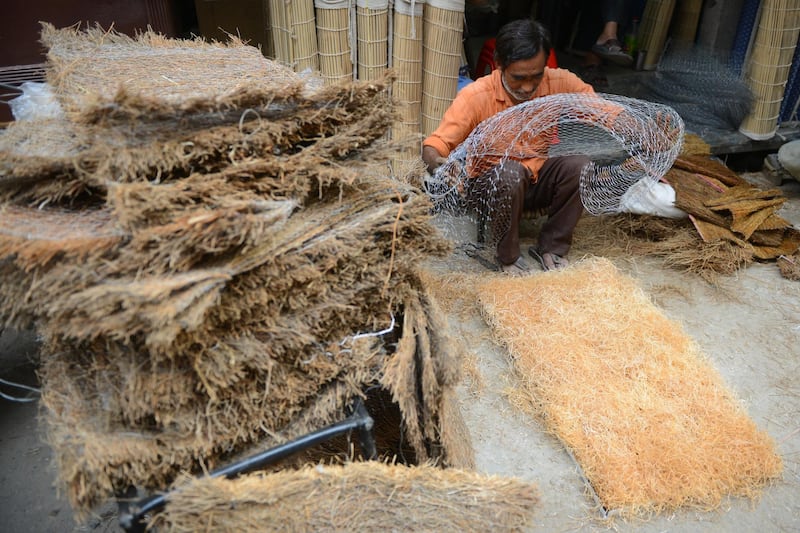In summers past, the onset of the dry heat in north India was marked by desert coolers coming to life. Installed on stilts outside ground-floor windows, or perched precariously on ledges abutting upper-floor apartments, these coolers were distinctive contraptions — their cuboid bodies made of gray-green metal, and their fans filling the air with a loud mechanical hum.
Until the 1990s, desert coolers were the best weapon that middle-class families could wield against the summer. Air conditioners were too expensive, and they consumed too much costly electricity. Ceiling fans merely stirred the hot air.
Coolers, though, were cheap — just a couple of thousand rupees (Dh104) per unit, compared to the tens of thousands of rupees for an AC — and they guzzled very little power. With coolers, you were paying, really, only for a metal cage with an inbuilt fan. The slatted sides of the cage held mats of khus — a fragrant grass, called vetiver in English, which was employed even by Mughal kings five centuries ago for its cooling properties.
To use the desert cooler, a sixth of it is filled with water, and its khus mats drenched. The hot air outdoors cools as it passes through the mats into the cage. Then, as the water evaporates, the air within the cage cools further, and the fan blows that cool, moist air into the room.
“We started switching the coolers on in mid-April, and the next few months would be spent arguing about whose turn it was to top up the water inside,” said Aditya Arora, an accountant who grew up and lives in Delhi.
“You could really only use the cooler until June or July. After that, the monsoon set in, and the cooler’s air became too humid for comfort,” Mr Arora said. “But for those two or three months, the cooler made life bearable.”
_________
Read more:
Monsoon rains subside in India’s Kerala but disease fears rise
Dubai’s Ice Beach is back: 3 ways to stay cool this summer
_________
As Indian families grew wealthier over the past two decades, though, and as the prices of air conditioners dropped, the desert cooler began to disappear. That makes Muhammad Muzammil a member of a fast-dwindling tribe.
Mr Muzammil, 19, sells khus mats. His father started the business nearly two decades ago, and his customers included those who purchased new coolers and those who replaced their older, frazzled mats with fresh ones, as advised, every summer.
At the time, Mr Muzammil remembered, “my father used to sell 40,000 or 50,000 sets of mats in a single summer”. A set of mats costs between 200 and 400 rupees, depending on the size of the cooler.
Mr Muzammil buys the mats wholesale, from vendors in the suburb of Ghaziabad, where machines cut and compress the khus into compact mats.

But sales have shrunk as ACs have replaced coolers. Mr Muzammil and his father barely touch the 20,000 mark these years.
Other salesmen have it even worse. Mohammad Akram, who sells khus mats to households in Delhi’s suburb of Gurugram, manages just 2,000 to 3,000 sets a summer.
“The AC has become the norm,” Mr Akram said. “Even if families can’t afford to purchase one outright, they’ll buy it and pay in instalments.” His too is a family business. “My uncle used to do this, and I used to watch him as a kid,” he said. Now he wonders if the business will survive at all.
The khus business was always a seasonal one. Once the monsoon arrives, and through the rest of the year leading up to the following summer, Mr Muzammil works as a day labourer on construction sites.
He admits that desert coolers can be a nuisance to maintain.
_________
Read more:
In the 'The Great Derangement' Amitav Ghosh urges us to confront climate change
Indian developers go green in push to reduce carbon footprint
How NYUAD research hopes to predict crucial changes to India's monsoons
__________
“Every year you need to buy these khus mats,” he said. “Then you have to refill these coolers with water every day or two.”
Water supplies become more erratic in Delhi’s fierce summer, so there’s little to spare for the cooler.
The stagnant water within the cooler also becomes a breeding ground for mosquitoes.
“People worry they’ll catch dengue,” Mr Muzammil said. Additionally, as peak summer temperatures have climbed over the past two decades, coolers have struggled to cope.
“Whereas with an AC, once you’ve installed it, then you don’t have to look after it anymore,” he said. The electricity bills are higher, of course, “but most people don’t seem to care about that these days”.
Desert coolers were best suited for residences, Mr Arora admits. It is difficult to imagine the large office complexes of modern Indian cities being kept cool by anything other than air conditioning.
Mr Arora’s family replaced their own desert coolers with ACs years ago, and he’s very glad for the icy breath that greets him when he comes indoors from the heat.
“But I still sometimes miss that sweet smell of khus in the summer,” he said. “It’s a nostalgia thing, I guess. It’s the smell of my childhood.”





